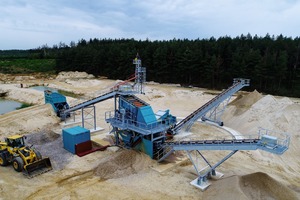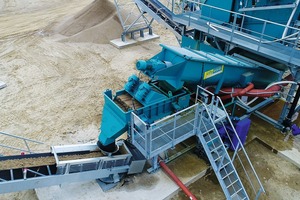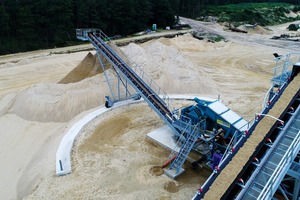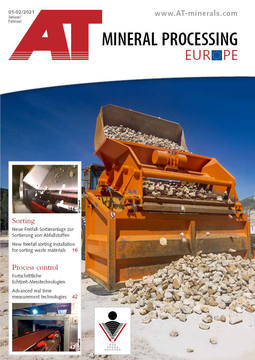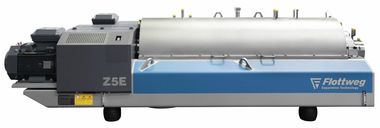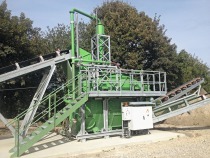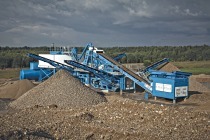New Clean Wash semi-mobile sand and gravel preparation plant to the company Roling
Pleasingly, Matthias Roling’s expectations at the new location were very quickly fulfilled, and he thus decided to invest in a modern facility.Operations on the basis of the used equipment provided the requirements for the future. The 85 % sand content in the run-of-quarry (ROQ) product has an ultra-fine sand content of approx. 25 % < 0.25 mm. The design of the used waterwheel is not capable of extracting these contents adequately. Remnants of roots caused quality limitations, depending on the areas quarried. The ultra-fine sand fractions were retained in a settling pond. Pond clearance proved to be space-consuming and expensive, and was a cause of fluctuating fine-sand quality.
The aim, therefore, was that of optimising operations, boosting performance and thus cutting costs while nonetheless assuring production. The many years of business relations with Christophel, the specialist in screening, crushing and washing technology from Lübeck, with a branch in Duisburg, thus became even more intense. A precise analysis of on-site circumstances took place. Christophel and Roling discussed the task and compared the pros and cons of cyclone technology, waterwheels and screw-conveyors for dewatering of the sand.
Matthias Roling took the decision in favour of the new “Clean Wash” semi-mobile wet preparation concept in early 2020. This convinced him with its modular structure, consisting of pre-fabricated components tailored to each other. These could then be delivered largely preassembled to the site, to be completed and then commissioned within an extremely short construction phase.The decisive advantage of Christophel’s modular “Clean Wash” concept is that the operator can select individually the sand-preparation systems described above to match the deposits. The operator does not adapt to the modular system concept, instead, the concept adapts to the operator.
Matthias Roling selected a screw-conveyor with the aim of reducing the ultra-fine sand fraction in 0 – 2a from 25 % to 12.5 %. A cyclone was to be used to avoid the pond management task and to recover the flushed off ultra-fine sand.The system consists in detail of the following components: a sizer guard above the 15 m³ bunker protects the high-quality wet preparation system against oversize particles. The sizer principle causes oscillations of the 45 mm thick sizer bars and the desired self-cleaning effect by oversize-particle extraction. The sand/gravel mixture requiring washing is passed over a 22 m long fully galvanised riser conveyor to the mechanical screen. At the transfer point to the V 15/40 screening module, the material is firstly soaked in water in a feed box. This facilitates separation into clean particles, and increases throughput.
The triple-deck screen frame driven by a shaft mounted in an oil bath separates at 32 mm, at 8 mm and at 2 mm. 85 nozzles distribute the 150 m³/h water necessary for this operation uniformly onto the screening decks. Precise and clean separation cuts are achieved from the interaction of the aggressive screen frame with the flow of water. The 2 – 8 mm and 8 – 32 mm fractions are stacked as required by means of stacker conveyors of individual lengths. The sand/water mixture of 0 – 2 mm is fed directly to the next module, the WSS100 screw-conveyor, via a pipe.
The screw-conveyor is the central element of the preparation plant. The feed position for the sand/water mixture into the screw-conveyor can be variably controlled, and the infinitely adjustable feed system enables Roling to flexibly control the sand, to match market requirements. A concrete-quality sand product containing 12.5 % fine sand suitable for DIN specifications is produced from the raw sand. In addition, the undesirable organic impurities are very largely washed out. The polyurethane segments on the 1000 mm screw-conveyor vanes assure robust, low-wear continuous operation.
The 0 – 2a mm sand is fed by means of a screw feeder to the WER 25/20 dewatering screen integrated into the WSS100 module. The dewatered sand is immediately suitable for shipment with a residual moisture content of 17 % and is then conveyed to the stack by means of a 22 m long pivoting belt conveyor. The belt has a discharge height of 6.50 m and can pivot within a radius of approx. 90 °. This can thus service a stack volume of approx. 2500 m3 for the main product. The ultra-fine sand fractions are conveyed via pipes together with the elutriable fractions into the integrated pump header tank. A pump of 22 kW is used to pump this mixture to the CVX 500 cyclone-tower module.
Careful design of the delivery pump and the pipe, plus that of the hydrocyclone itself, assures precise separation of the elutriable constituents into the overflow of the settling pond. The ultra-fine sand ready for stacking is extracted via the freely adjustable underflow gasket on the cyclone underflow and a pivoting pipe system. This sand is also easily marketable, containing only 0.2 % elutriable constituents, 86.5 % < 0.25 mm and 99.2 % up to 0.5 mm. The use of the cyclone module provides Roling sales of an additional sand product and significantly reduces the clearance work on the settling pond.The tried-and-proven Siemens control system installed in a 10’ container monitors the production process and is also easy and reliable to operate, after a short familiarisation phase.
The prefabricated modular system permitted an extremely short setting-up phase. It was possible to start production after only three weeks. Thanks to precise cooperation in our presence during the construction phase, it proved possible to produce a DIN-conformant concrete aggregate with practically the very first shovelful. Output has been increased by 60 %.The washed 0 – 2 mm sand meets all the preconditions for the concrete industry and is immediately ready for shipping. The washed 2 – 8 mm and 8 – 32 mm particle fractions are cleanly cut and can also be easily marketed. And a new product has been gained, 0 – 0.5 mm sand. In addition, the use of the cyclone technology reduces the burden on the settling pond. The daily clearance task is now omitted. The new system also offers significantly better operational safety for all persons involved. In turbulent times, the Itterbeck deposits have, with the new wet preparation plant, become the basis for stability and cost-effectiveness.

